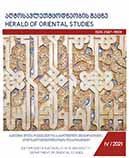იაპონური აზროვნების ლაბირინთებში
In labyrinths of Japanese way of thinking
Author(s): Mariam ChalabashviliSubject(s): Cultural history, History of ideas, Social history, East Asian Philosophy
Published by: ბათუმის შოთა რუსთაველის სახელმწიფო უნივერსიტეტი, ჰუმანიტარული მეცნიერებატა ფაკულტეტის აღმოსავლეთმცოდნეობის დეპარტამენტის „ელექტრონული ჟურნალი“.
Keywords: ikigai;wabi-sabi;
Summary/Abstract: Japanese mainstream way of thinking prevails as a puzzle for the whole world including Georgia. Several Japanese words and phrases are hard to grasp even after the translation; Ikigai (生き甲斐) and Wabi-sabi (わびさび) are the two striking examples. Both of them could be deemed as not only words, but also as the way of thinking or the way of life.The word etymology of Ikigai (the reason, value of life) derives from the Heian period (794-1185). According to the clinical psychologist Akihiro Hasegawa, Gai comes from the Japanese word Kai - shell; during the Heian period (as well as much earlier) shells were perceived highly valuable as artists decorated them by hand, and used them in a shell-matching game called Kaiawase. Kaiis also used in other Japanese words and actual verbs such as hatarakigai (the value of working); yarigai (the value of doing) and asobigai (the value of playing). Since Gai relates to value, Ikigai could also be translated as the value of life, something worth living for. The concept of Ikigai could be compared to a sunflower, the sunflower seeds in the center could be perceived as the source of Ikigai and petals of the flower as one’s feeling about the ikigai object - Ikigai-kan (Ikigai feeling). As the Japanese proverb goes, "ten people, ten colours". Therefore, Ikigai could be as diverse as the number of people and the Japanese tend to follow their own Ikigai, without clarifying the word.Another Japanese concept - Wabi-sabi (which gradually transformed its initial gloomy connotation since 14th century) offers us to perceive beauty even inimpermanence, incompletion and imperfection. Even though, the concept is intricately entangled with the everyday life, that makes it very difficult for Japanese people to convey the meaning, the essence of Wabi-sabi could be comprehended in the ancient craft of Kintsugi and Japanese house design as well.
Journal: საერთაშორისო სამეცნიერო ჟურნალი „აღმოსავლეთმცოდნეობის მაცნე“
- Issue Year: 4/2021
- Issue No: 1
- Page Range: 8-19
- Page Count: 12
- Language: Georgian

